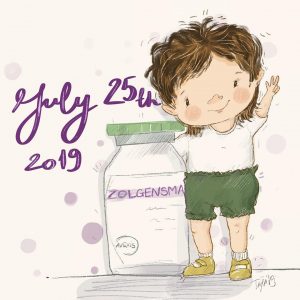‘Small Differences’ That Mark SMA Type 2 in Baby Girl Bring Family from UK to Ohio for Zolgensma Treatment

A drawing of Tora standing alongside Zolgensma, done by her mother to mark her approval for treatment.
When she was born in London on Sept. 9, 2018, Tora Patgiri showed no signs of the spinal muscular atrophy (SMA) type 2 she would be officially diagnosed with some eight months later in Ohio.
The baby ate well, waved her arms easily, and grasped objects at will. Until a December family ski trip to southern France and its roughly 10-hour one-way car ride, she “could even do things like hold up her head when lying on her belly,” her father, Rajdeep Patgiri, said in an interview with SMA News Today.
“Everything was normal” with his 3-month-old girl, Patgiri said, before correcting himself to add “or at least what was not normal was not evident to us, because we are not trained to look for such small differences.”
And so the Patgiri family of three — Rajdeep, a 40-year-old financial analyst with GSA Capital, his wife Taisiya Usova, who soon will be 32, and Tora, their only child — began a journey with SMA that would take them from London to New York to Nationwide Children’s Hospital in Columbus, Ohio, where Tora, now more than 10 months old, finally would be treated with Zolgensma, the gene therapy approved in May by the U.S. Food and Drug Administration.
Along the way, her parents faced the shock of learning they had passed to their child a genetic disease they had never heard of, struggles with treatment choices, and insurance appeals and denials.
“It came completely out of the blue,” Patgiri said of SMA, “neither of our families have any neuromuscular disease [history] at all.”
Ask questions and share your knowledge of Spinal Muscular Atrophy in our forums.
‘Baby doesn’t move her legs’
Back home in January, Tora’s parents were in equal measure frightened and confused at the changes in their daughter.
Usova, on a visit to a friend whose baby is about a month older than her own, made a video of that girl’s movements and of Tora’s. She emailed the telling recordings to her husband, who also saw a “huge” difference.
An online search of phrases like “baby doesn’t move her legs” brought Patgiri to a “mom’s meet” channel, where a discussion of spinal muscular atrophy was underway in a reference that echoed his inquiry. That afternoon, the couple took Tora to a local hospital emergency room, where a pediatrician declared all was fine and advised they “wait and see how it develops.”
The pediatrician’s report, however, caught the eye of someone in the hospital’s neurology department, and a letter arrived some 10 days later, Feb. 5, recommending a return visit. A series of neurologic and physical exams were followed by a blood draw for a genetic test. No word was given, but “I think they knew,” Patgiri said. A Feb. 20 appointment was set for Great Ormond Street Hospital, a larger and more specialized London facility.
“That’s when the news was given to us, that she has type 1 but borderline, classified as 1C … [that] might progress to type 2,” Patgiri said.
With no SMA treatment available in England — “only Scotland, surprisingly,” Patgiri said, has concluded negotiations with Biogen for Spinraza (nusinersen) to enter that country’s national health plan — the family looked to alternatives, including a move to the U.S.
Fortunately, Tora did not have full-blown type 1 SMA, the most severe subtype caused by mutations in the SMN1 gene that leaves little SMN protein for motor nerve cells and the muscles dependent on them. Her disease, while progressing, did so slowly in comparison.
“She has never had any chest breathing or need for ventilator support,” her father said, interviewed less than 48 hours before Tora’s Zolgensma treatment. “She can sit but absolutely cannot bear any weight on her legs. … But otherwise, she’s healthy for someone with SMA, I would say.”
GSA Capital has a New York satellite office that the company was looking to grow, and a position open for someone with Patgiri’s skills. His company helped with the transfer and securing a work visa in “less than five weeks, which is really quick,” and the family was stateside by April.
They considered treating Tora in nearby Boston, but ultimately went with Nationwide Children’s Hospital because Jerry Mendell, a pediatric neurologist with a nearly unmatched expertise in neuromuscular disease and gene therapy, was there. Mendell began early work on what would become Zolgensma and led the trial that supported its approval.
A May 14 first meeting at Nationwide, attended by Mendell and Anne Connolly (Tora’s neurologist) among others, led to Tora getting an official type 2 SMA diagnosis and expectations that the family soon would enroll in the STRONG Phase 1 clinical trial (NCT03381729) for babies and children up to age 5 with that particular subtype. STRONG uses intrathecal (spinal cord) injection rather than the intravenous (IV) delivery approved by the FDA.
“They said she would be a good trial candidate and they had two open slots,” Patgiri said. “Everything looked good, hopefully they would get their paperwork soon … and we should be dosed within the next two weeks or so, by the end of May. But, unfortunately, it just kept dragging on.”
Then came the FDA announcement on May 24, opening Zolgensma to all SMA patients up to age 2 — provided they could get coverage for the $2.125 million retail price that Novartis, which acquired AveXis in 2018, put on the possibly one-time treatment.
“Around mid-June, we had to make a choice,” Patgiri said. “Either we wait for the trial or we submit an application to our health insurer for commercial route. I think that’s the point at which I said, ‘OK, let’s go for the commercial.’
“That’s how we ended up with [insurance] denial, appear to clear, then denial upheld, then approval,” he added.
Insurance challenges
Through his company, Patgiri had coverage with a major health policy carrier, United Healthcare. He credits that insurer with having been among the first, if not the first, to issue a policy for Zolgensma. But that May 29 policy was limited — UHC is on record saying its policies adhere to clinical trial data — and Tora did not meet its age (up to 6 months) or disease type (1 only) restrictions.
A first denial came on June 25, the same day UHC released a more sweeping Zolgensma coverage plan much closer to the FDA’s view of eligibility.
“I saw the updated policy first, and two hours later I got the denial letter,” Patgiri said. “It was a strange day.”
Their neurologist, Connolly, intervened, arranging an appeal in the form of a peer-to-peer review — or doctor-to-doctor conversation — with United Healthcare. But the doctor assigned for this July 3 talk was a pediatrician and not a pediatric neurologist, “and didn’t have the authority to overturn the initial denial,” Patgiri said. The decision stood.
An internal appeal with specific documents, including a CHOP-Intend score (used to measure motor skills) of at least 40 and “more detail about the medical necessity of the treatment” was advised, in keeping with UHC’s newly articulated policy.
The denial letter made no reference to age limits, SMA types, or test scores. Rather, it “stated that they didn’t consider it a medical emergency, nothing more,” something Patgiri and his wife, now quite familiar with their daughter’s disease, thought “somewhat offensive.”
Connolly and others at Nationwide hospital submitted the appeal and its documents “as an urgent review” on July 9.
Patgiri followed with a call to UHC a few days later, where he learned his daughter’s request wasn’t “considered to be urgent … and downgraded to a standard case” whose “turnaround time” would be another 15 business days.
A battery of phone calls consumed the next days. A new CHOP-Intend score of 44, well above the 37 that concluded an earlier daylong series of exams that left Tora “tired, hungry, angry and [not wanting] to do much on CHOP-Intend” followed on July 17. Patgiri emailed it to three contacts he had at UHC. Somehow, the efforts broke through.
The family’s case manager reached Patgiri at a physical therapy session with Tora near their Dublin, Ohio, home on July 18 with news of the baby’s approval for treatment.
“It was a massive, massive relief,” Patgiri said. Dosing was set for next Thursday, July 25, at Nationwide Children’s.
He would later learn the specific language that, for UHC, would label Tora’s application urgent rather than standard: The neurologist submitting the appeal must “certify” that a delay in the treatment “could seriously jeapordize the patient’s health and ability to regain maximum function.”
Looking for improvements
Treatment day itself was both eventful and routine, Patgiri said. The family arrived at the infusion center at 7 a.m., only to be told the Zolgensma was not yet onsite and a delay was possible. But once that cleared, finding a vein to place the IV was the sole frustration.
“They had to poke about five or six times, until finally they brought in an ultrasound to look where exactly to go in,” Patgiri said. “That was a bit stressful, but once it started it was OK. Very routine.”
As requested, her parents kept Tora awake to help the Zolgensma infuse throughout her system. Then, 57 minutes later, all was done.
Her fever began climbing Sunday night, but dropped after reaching 101°F (38.3°C) and a hospital visit wasn’t thought necessary, though her doctors and parents kept in close touch Monday.
“We’re happy and excited. We’re looking for some improvements, but I think it’s a bit too early,” Patgiri said.
“Before this, we were always looking for things that might deteriorate. Now it’s … improvements rather than deterioration,” he said.
This gene therapy’s multi-million-dollar price, like the exorbitant cost of so many newer medicines, always will be a little outside his comfort zone, Patgiri said. He understands that many potential therapies fail in clinical trials and their development costs are simply assumed by pharmaceutical companies and other investors, “and I think prices do account for that.”
Still, “these prices do make treatments unaffordable for a lot of people,” he added. Those in developed countries like the U.S. and U.K. are “fortunate” because access — however difficult — exists. “But in countries like India, where I was born, it’s absolutely impossible for anyone suffering from SMA to even dream about treatments with such price tags.”










